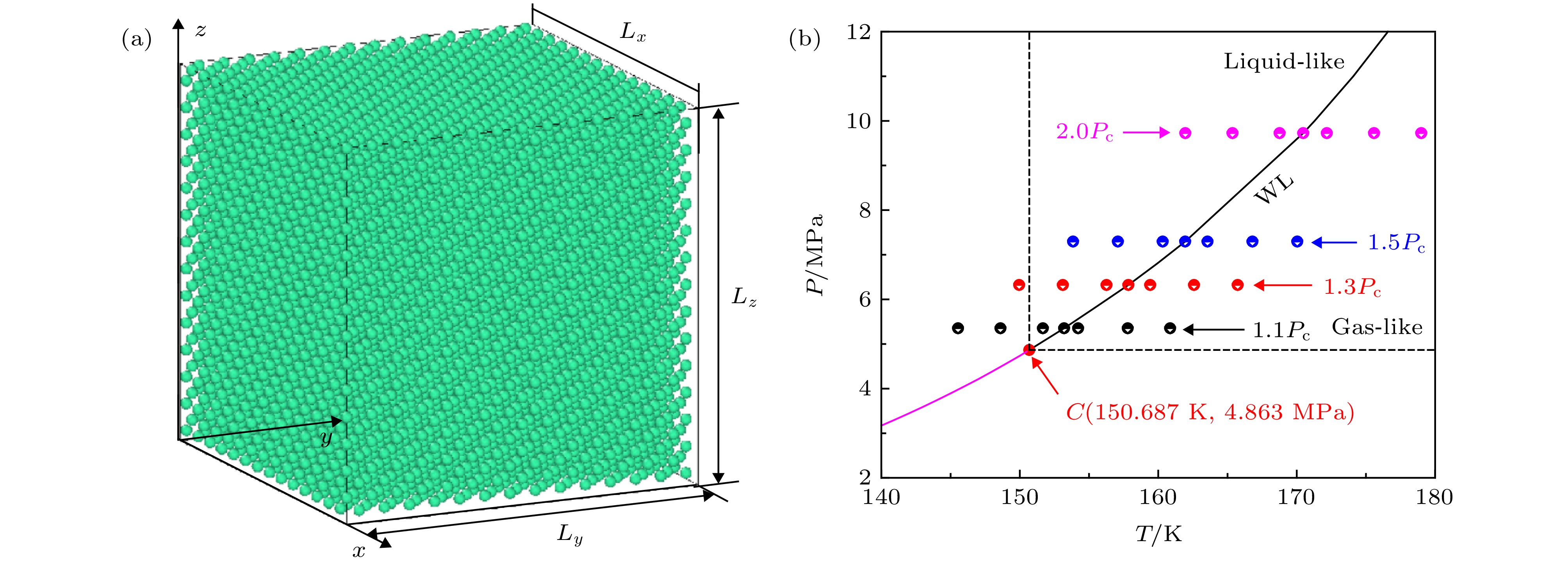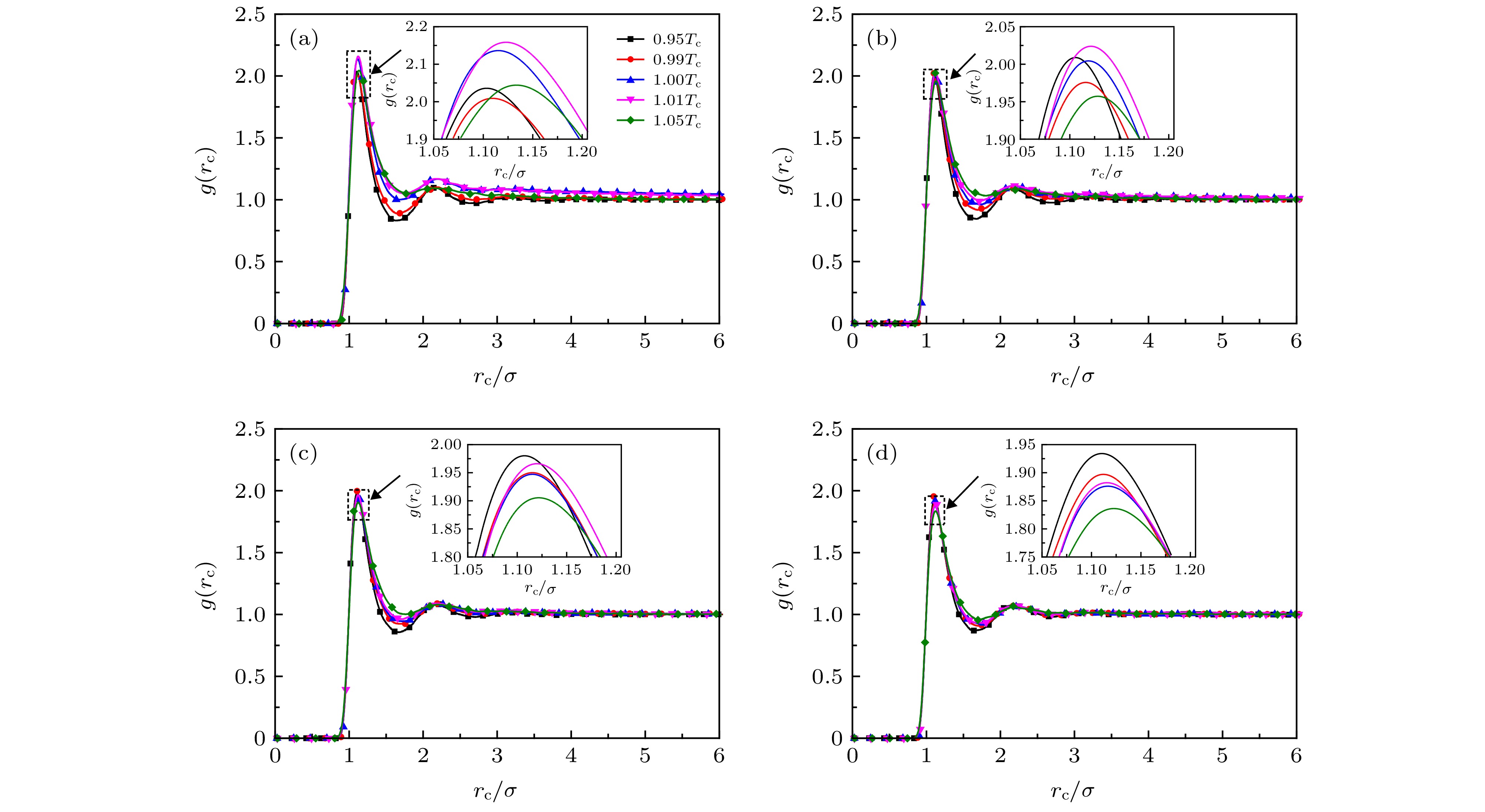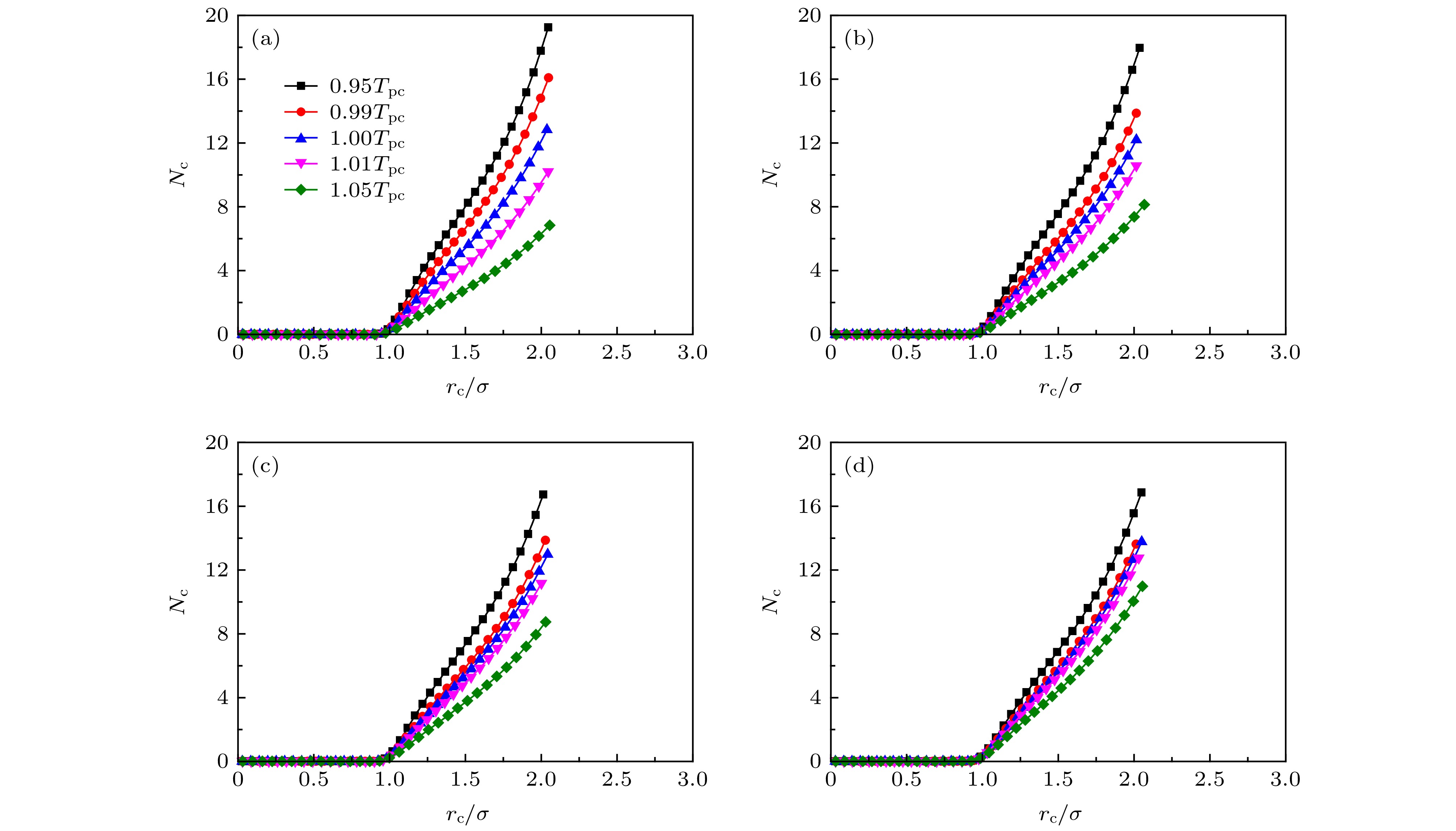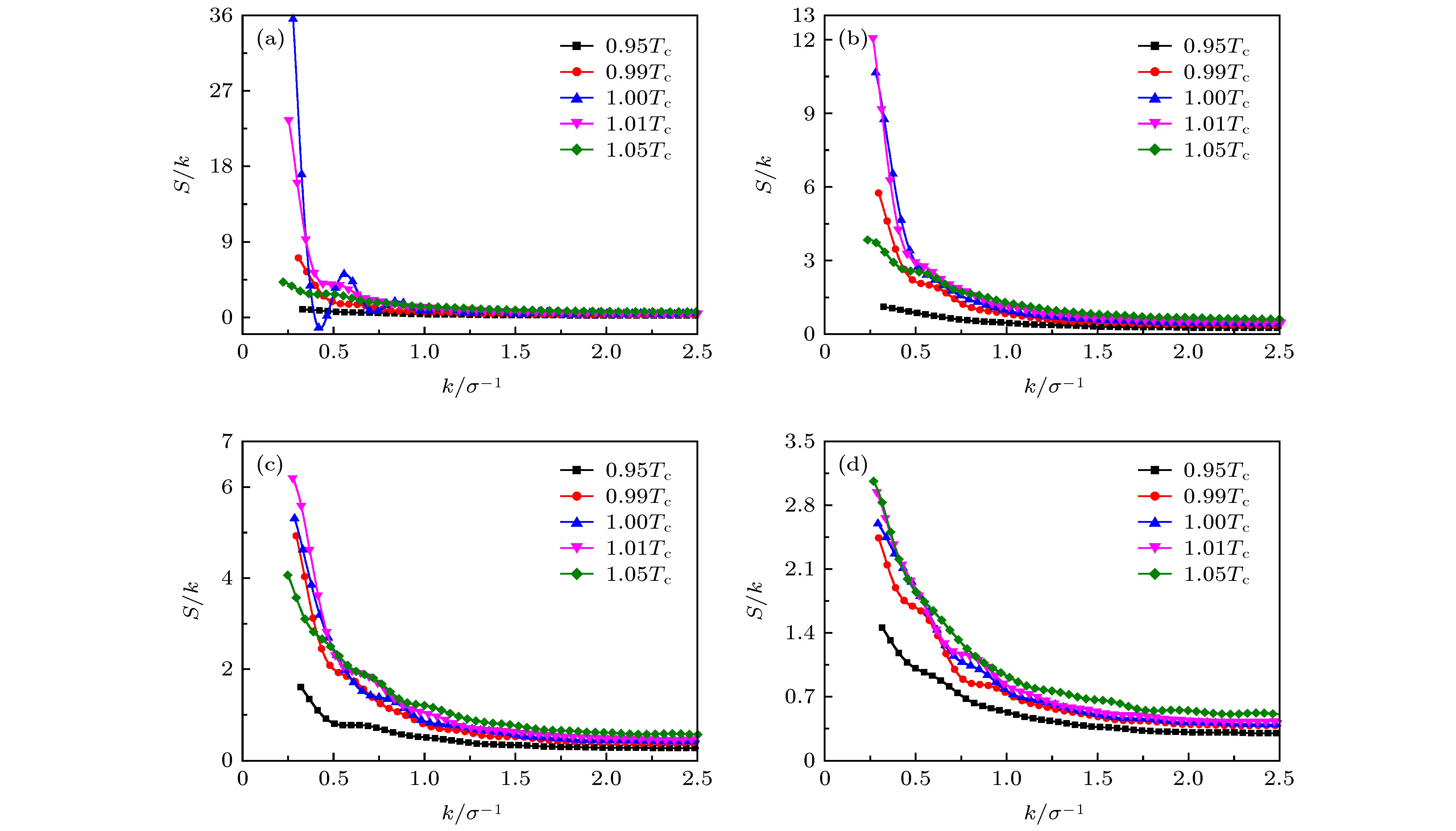-
研究超临界流体在不同压力和温度的结构特征有助于深刻理解并有效利用超临界流体. 本文采用分子动力学方法模拟超临界压力、拟临界温度附近流体的结构及密度波动曲线的排列熵, 分析状态参数变化的影响. 结果表明, 定压下, 径向分布函数随温度升高, 第一峰值位置逐渐向右移动, 但右移幅度随着压力偏离临界点距离的增大而减弱, 近临界压力时, 出现峰值最高点的工况和等温压缩系数的极值点位置一致, 压力增大, 该现象消失. 低压力拟临界点时易出现面积大、相对集中且分布稳定的高/低密度区, 无明显嵌套现象. 静态结构因子存在一定发散行为, 发散的最大值和等温压缩系数极值点所处工况符合. 低压力时密度时间序列的波动幅度最大, 类周期现象较明显. 在分子间势能、等温压缩系数和热运动效应的共同作用下, 当压力(P)为1.1倍的临界压力(Pc)时, 排列熵在0.99倍的拟临界温度(Tpc)达到最小值, P = 1.3Pc和1.5Pc时, 最小排列熵与等温压缩系数的最大值工况点保持一致, 压力继续增大, 各模拟工况密度和排列熵的波动减弱, 流体均匀性增强.Supercritical fluids (SCF) have been widely utilized in the industrial processes, such as extraction, cleaning, drying, foaming and power generation driven by primary energy. Therefore, SCF have attracted more and more attention in recent years. At supercritical state, liquid, and gas phase are not clearly distinguished, but the thermal-physical properties of fluid show an interesting characteristic, especially near the pseudo-critical temperature. Thus, it is of great significant to study the structure and density time series evolution of SCF.Due to high pressure and temperature for SCF, it can be challenging to collect experimental data of SCF. However, the advantage of molecular dynamics simulation in convenience, safty and cost over experiments. Therefore, in this paper,molecular dynamics simulation was performed to investigate the fluid structure and density series fluctuation curves at supercritical state, and the influence of parameters varitation including pressure and temperature onstructural characteristics was analyzed. In the simulation system, more than 104 atoms and simple Lennard-Jones(LJ) supercritical fluids were contained. The radial distribution function(RDF), coordination number(CN), density time series curve and permutation entropy of fluids at different pressures and temperatures were calculated. At specified pressure, the position of the first peak value of RDF gradually moves to the right with the increase of temperature, and the trend weakens with the increase of pressure. CN shows a downward trend with the increase of pressure and the CN difference at different temperatures gradually decreases. Simultaneously, the CN distribution area becomes narrow with the increase of pressure. The high/low density region calibrated by CN is stable, concentrated and large area distribution at low pressure, and the average density region is small, with the increase of pressure, the area of high/low density region is only a size of a few molecular and fluctuates sharply with time, and the area of average region is constantly expanding. At relatively low pressure, the density time series curve shows the characteristic that both the fluctuation range and quasi-period are large at pseudo-critical temperature. Simultaneously, the permutation entropy obtained from the time series curve shows three cases: (i) at low pressure (P = 1.1Pc), the minimum permutation entropy is obtained under the temperature that is lower than pseudo-critical temperature, and the system has higher orderliness; (ii) at moderate pressure (P = 1.3Pc and 1.5Pc), the state points corresponding to minimum permutation entropy is consistent with that corresponding to the maximum of isothermal compression coefficient and (iii) at high pressure (P = 2.0Pc), the permutation entropy curve fluctuates slightly and remains basically on the horizontal line. The results provide reliable support for revealing the characteristics of SCF from the microscale, and also provide useful inspiration for the practical application of SCF.
-
Keywords:
- supercritical fluids /
- molecular dynamics /
- structure characteristics /
- permutation entropy
[1] Pena-Pereira F, Tobiszewski M 2017 Elsevier 155
[2] Carlès P 2010 J. Supercrit. Fluids 53 2
 Google Scholar
Google Scholar
[3] Raju M, BanutiD T, MaP C, Ihme M 2017 Sci. Rep.-UK 7 3027
 Google Scholar
Google Scholar
[4] Artemenko S, Krijgsman P, Mazur V 2017 J. Mol. Liq. 238 122
 Google Scholar
Google Scholar
[5] Brazhkin V V, Fomin Y D, Lyapin A G, Lyapin V V, Ryzhov V N, TsiokE N, Trachenko Kostya 2013 Phys. Rev. Lett. 111 145901
 Google Scholar
Google Scholar
[6] Fomin Y D, Ryzhov V N, Tsiok E N, Brazhkin V V 2015 Sci.Rep.-UK 5 14234
 Google Scholar
Google Scholar
[7] Banuti D T, Raju M, Ihme M 2017 Cent. Turbul. Res. Annu. Res. Briefs 165
[8] Banuti D T 2015 J.Supercrit.Fluids. 98 12
 Google Scholar
Google Scholar
[9] Raman A S, Li H, Chiew Y C 2018 J. Chem. Phys. 148 014502
 Google Scholar
Google Scholar
[10] Nichele J, Abreu C R A, Alves L S B, Jr I B 2018 J.Supercrit.Fluids. 135 225
 Google Scholar
Google Scholar
[11] Nichele J, de Oliveira A B, Alves L S B, Borges I 2017 J. Mol.Liq. 237 65
 Google Scholar
Google Scholar
[12] Egorov S A 2002 Chem. Phys. Lett. 354 140
 Google Scholar
Google Scholar
[13] Skarmoutsos I, Samios J 2007 J. Chem. Phys. 126 044503
 Google Scholar
Google Scholar
[14] Skarmoutsos I, Samios J 2006 J. Phys. Chem. B 110 21931
 Google Scholar
Google Scholar
[15] Yoshii N, Okazaki S 1998 Fluid PhaseEquilib. 144 225
[16] Yoshii N, Okazaki S 1997 J. Chem. Phys. 107 2020
 Google Scholar
Google Scholar
[17] Metatla N, Lafond F, Jay-Gerin J P, Soldera A 2016 Rsc. Adv. 6 30484
 Google Scholar
Google Scholar
[18] Maddox M W, Goodyear G, Tucker S C 2000 J. Phys. Chem. B 104 6248
 Google Scholar
Google Scholar
[19] Yamane A, Shimojo F, Hoshino K 2006 J. Phys. Soc.Jpn. 75 124602
 Google Scholar
Google Scholar
[20] Nishikawa K, Arai A A, Morita T 2004 J.Supercrit.Fluids. 30 249
 Google Scholar
Google Scholar
[21] Nishikawa K, Ochiai H, Saitow K, Morita T 2003 Chem. Phys. 286 421
 Google Scholar
Google Scholar
[22] Cabaço M I, Besnard M, Tassaing T, Danten Y 2004 Pure Appl. Chem. 76 141
 Google Scholar
Google Scholar
[23] Arai A A, Morita T, Nishikawa K 2007 Fluid Phase Equilibria. 252 114
 Google Scholar
Google Scholar
[24] Ghosh K, Krishnamurthy C V 2018 Phys. Rev. E 97 012131
[25] 陈正隆, 徐为人, 汤立达 2007 分子模拟的理论与实践 (北京: 化学工业出版社) 第110−112页
Chen Z L, Xu W R, Tang L D 2007 (Beijing: Chemical Industry Press) pp110−112 (in Chinese)
[26] Bolmatov D, Brazhkin V V, Fomin Y D, Ryzhov V N, Trachenko K 2013 J. Chem. Phys. 139 234501
 Google Scholar
Google Scholar
[27] 吴方棣, 郑辉东, 刘俊劭, 郑细鸣 2014 辽宁石油化工大学学报 34 8
 Google Scholar
Google Scholar
Wu F K, Zheng H D, Liu J X, Zheng X M 2014 Journal of Liaoning Shihua University 34 8
 Google Scholar
Google Scholar
[28] Skarmoutsos I, Guardia E, Samios J 2017 J.Supercrit.Fluids. 130 156
 Google Scholar
Google Scholar
[29] 计伟荣 1993 浙江工业大学学报 59 1
Ji W R 1993 Journal of Zhejiang University of Technology 59 1
[30] Martinez H L, Ravi R, Tucker S C 1996 J. Chem. Phys. 104 1067
 Google Scholar
Google Scholar
[31] 于渌, 郝柏林, 陈晓松 2016 边缘奇迹:相变和临界现象 (北京: 科学出版社) 第81−93页
Yu L, Hao B L, Chen X S 2016 (Beijing: Science Press) pp81−93 (in Chinese)
[32] March N H, Tosi M P 2002 (Singapore: World Scientific) pp75−80
[33] Bandt C, Pompe B 2002 Phys. Rev. Lett. 88 174102
 Google Scholar
Google Scholar
-
-
[1] Pena-Pereira F, Tobiszewski M 2017 Elsevier 155
[2] Carlès P 2010 J. Supercrit. Fluids 53 2
 Google Scholar
Google Scholar
[3] Raju M, BanutiD T, MaP C, Ihme M 2017 Sci. Rep.-UK 7 3027
 Google Scholar
Google Scholar
[4] Artemenko S, Krijgsman P, Mazur V 2017 J. Mol. Liq. 238 122
 Google Scholar
Google Scholar
[5] Brazhkin V V, Fomin Y D, Lyapin A G, Lyapin V V, Ryzhov V N, TsiokE N, Trachenko Kostya 2013 Phys. Rev. Lett. 111 145901
 Google Scholar
Google Scholar
[6] Fomin Y D, Ryzhov V N, Tsiok E N, Brazhkin V V 2015 Sci.Rep.-UK 5 14234
 Google Scholar
Google Scholar
[7] Banuti D T, Raju M, Ihme M 2017 Cent. Turbul. Res. Annu. Res. Briefs 165
[8] Banuti D T 2015 J.Supercrit.Fluids. 98 12
 Google Scholar
Google Scholar
[9] Raman A S, Li H, Chiew Y C 2018 J. Chem. Phys. 148 014502
 Google Scholar
Google Scholar
[10] Nichele J, Abreu C R A, Alves L S B, Jr I B 2018 J.Supercrit.Fluids. 135 225
 Google Scholar
Google Scholar
[11] Nichele J, de Oliveira A B, Alves L S B, Borges I 2017 J. Mol.Liq. 237 65
 Google Scholar
Google Scholar
[12] Egorov S A 2002 Chem. Phys. Lett. 354 140
 Google Scholar
Google Scholar
[13] Skarmoutsos I, Samios J 2007 J. Chem. Phys. 126 044503
 Google Scholar
Google Scholar
[14] Skarmoutsos I, Samios J 2006 J. Phys. Chem. B 110 21931
 Google Scholar
Google Scholar
[15] Yoshii N, Okazaki S 1998 Fluid PhaseEquilib. 144 225
[16] Yoshii N, Okazaki S 1997 J. Chem. Phys. 107 2020
 Google Scholar
Google Scholar
[17] Metatla N, Lafond F, Jay-Gerin J P, Soldera A 2016 Rsc. Adv. 6 30484
 Google Scholar
Google Scholar
[18] Maddox M W, Goodyear G, Tucker S C 2000 J. Phys. Chem. B 104 6248
 Google Scholar
Google Scholar
[19] Yamane A, Shimojo F, Hoshino K 2006 J. Phys. Soc.Jpn. 75 124602
 Google Scholar
Google Scholar
[20] Nishikawa K, Arai A A, Morita T 2004 J.Supercrit.Fluids. 30 249
 Google Scholar
Google Scholar
[21] Nishikawa K, Ochiai H, Saitow K, Morita T 2003 Chem. Phys. 286 421
 Google Scholar
Google Scholar
[22] Cabaço M I, Besnard M, Tassaing T, Danten Y 2004 Pure Appl. Chem. 76 141
 Google Scholar
Google Scholar
[23] Arai A A, Morita T, Nishikawa K 2007 Fluid Phase Equilibria. 252 114
 Google Scholar
Google Scholar
[24] Ghosh K, Krishnamurthy C V 2018 Phys. Rev. E 97 012131
[25] 陈正隆, 徐为人, 汤立达 2007 分子模拟的理论与实践 (北京: 化学工业出版社) 第110−112页
Chen Z L, Xu W R, Tang L D 2007 (Beijing: Chemical Industry Press) pp110−112 (in Chinese)
[26] Bolmatov D, Brazhkin V V, Fomin Y D, Ryzhov V N, Trachenko K 2013 J. Chem. Phys. 139 234501
 Google Scholar
Google Scholar
[27] 吴方棣, 郑辉东, 刘俊劭, 郑细鸣 2014 辽宁石油化工大学学报 34 8
 Google Scholar
Google Scholar
Wu F K, Zheng H D, Liu J X, Zheng X M 2014 Journal of Liaoning Shihua University 34 8
 Google Scholar
Google Scholar
[28] Skarmoutsos I, Guardia E, Samios J 2017 J.Supercrit.Fluids. 130 156
 Google Scholar
Google Scholar
[29] 计伟荣 1993 浙江工业大学学报 59 1
Ji W R 1993 Journal of Zhejiang University of Technology 59 1
[30] Martinez H L, Ravi R, Tucker S C 1996 J. Chem. Phys. 104 1067
 Google Scholar
Google Scholar
[31] 于渌, 郝柏林, 陈晓松 2016 边缘奇迹:相变和临界现象 (北京: 科学出版社) 第81−93页
Yu L, Hao B L, Chen X S 2016 (Beijing: Science Press) pp81−93 (in Chinese)
[32] March N H, Tosi M P 2002 (Singapore: World Scientific) pp75−80
[33] Bandt C, Pompe B 2002 Phys. Rev. Lett. 88 174102
 Google Scholar
Google Scholar
计量
- 文章访问数: 17712
- PDF下载量: 213
- 被引次数: 0














 下载:
下载:








